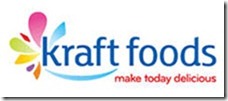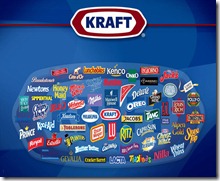 Kraft Foods made some surprising news this past week, announcing that it is splitting itself into two separate entities. One entity is comprised of Kraft’s $32B global snack business, with brands such as Oreos, recently-acquired Cadbury, and its other candies and gums. The second business entity is its North American Grocery business, comprised of Kraft’s long-time brands, including Kraft Macaroni and Cheese, Philadelphia Cream Cheese, and Maxwell House coffee – a business unit that totals about $16B in sales. Remember when Kraft merged with Nabisco in 2000? Kraft’s global snack business, now coupled with Cadbury, may, again, stand alone.
Kraft Foods made some surprising news this past week, announcing that it is splitting itself into two separate entities. One entity is comprised of Kraft’s $32B global snack business, with brands such as Oreos, recently-acquired Cadbury, and its other candies and gums. The second business entity is its North American Grocery business, comprised of Kraft’s long-time brands, including Kraft Macaroni and Cheese, Philadelphia Cream Cheese, and Maxwell House coffee – a business unit that totals about $16B in sales. Remember when Kraft merged with Nabisco in 2000? Kraft’s global snack business, now coupled with Cadbury, may, again, stand alone.
Kraft follows companies such as Sara Lee and Fortune Brands, each of whom  announced this year they are splitting themselves into parts by way of spin-off to create stand-alone companies. The business heads who had very recently touted their efficiency in size and strength dealing with retailer partners such as Walmart, have found that a perceived lack of focus may be hurting them in a more important way.
announced this year they are splitting themselves into parts by way of spin-off to create stand-alone companies. The business heads who had very recently touted their efficiency in size and strength dealing with retailer partners such as Walmart, have found that a perceived lack of focus may be hurting them in a more important way.
Management discovered (likely through outside stock analysts) that the company and its stock price is undervalued because of the combination of different businesses. As one segment may operate in a slower growth, non-global markets (likely the US) the other is operating in a higher growth, global category. The business in growth is tethered to a non-growth internal partner. Kraft’s Cadbury business, strong in India and Asia, is tethered to a slow growth US domestic grocery business that analysts predict to grow at between 2% – 4% annually. Sara Lee’s International Coffees business is tethered to a domestic deli and packaged meats business, and Fortune Brands’ global spirits is tethered to household goods markets such as windows, faucets and home security. While some of the slower growth business units may perform well, they lack global recognition and distribution, which is where management is sees most of their companies’ futures.
The about-face, however, may be abrupt. Once corporate boards recognize the stock-price impact of unlocked value, they need to move quickly towards one in a set of strategic options:
- Seek to turn around the slow growth domestic business through innovation and steal massive market share from competitors (an unlikely scenario, one in which Kraft and others have not demonstrated success).
- Risk being gobbled up by a competitor who will, in turn, split the company and unlock value for themselves.
- Split the company to either:
- Continue as-is, allowing investors to choose either safety and dividends or a growth investment.
- Take the resulting equity windfall to purchase other smaller entities on the way to more growth.
- Attract potential bidders who, upon bidding for the pure-play, start at a higher place than they would if the business were combined.
The brand and marketing implications are less clear. In a stagnant domestic market, innovation and market share growth remain essential, but likely not enough to hit the annual targets that Wall Street wants management to set for a growth company. Corporations will position these splits as good for company focus – strengthening teams and providing growth in their market segments with winning brands. Winning brand, however, is based upon innovation, deeper consumer insights, and delighting the consumer. Company splits are only about the value of the stock and the future ownership of the organization. There is certainly huge distraction for employees as well.

